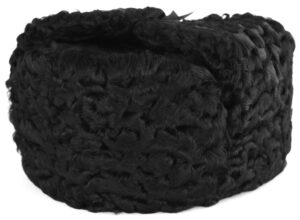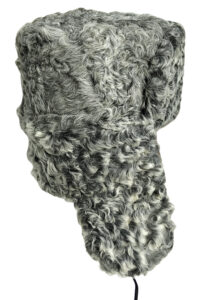 When it comes to national stereotypes, it would probably be fair to say that winter trapper hats are the first to come to mind when Russian headwear is a topic. Although its earlier versions were many and could arguably be traced back to the Mongol times, the Russian ushanka hat as we know it today did originate in the USSR. In 1930s, the Soviet Navy personnel were the first to receive an adapted version made of sheepskin and leather. The remaining military forces followed suit around 1940 after the Red Army had commissioned a complete redesign of winter uniforms.
When it comes to national stereotypes, it would probably be fair to say that winter trapper hats are the first to come to mind when Russian headwear is a topic. Although its earlier versions were many and could arguably be traced back to the Mongol times, the Russian ushanka hat as we know it today did originate in the USSR. In 1930s, the Soviet Navy personnel were the first to receive an adapted version made of sheepskin and leather. The remaining military forces followed suit around 1940 after the Red Army had commissioned a complete redesign of winter uniforms.
 As a result, shapka (шапка, hat) ushanka was born. Its meaning comes from the Russian word for ears (уши [oo’shi]), which refers to the characteristic flaps. However, these do not cover just the ears. As a side benefit, back of the neck, cheeks, and chin could also be protected when draw strings are tied in the open hat setup. Certain models come with extra long flaps that can even be fastened to greatcoat collars using extra buttons. This applies to the hats worn by troops serving beyond the Arctic Circle in Russia. Few other places on Earth require such wardrobe measures.
As a result, shapka (шапка, hat) ushanka was born. Its meaning comes from the Russian word for ears (уши [oo’shi]), which refers to the characteristic flaps. However, these do not cover just the ears. As a side benefit, back of the neck, cheeks, and chin could also be protected when draw strings are tied in the open hat setup. Certain models come with extra long flaps that can even be fastened to greatcoat collars using extra buttons. This applies to the hats worn by troops serving beyond the Arctic Circle in Russia. Few other places on Earth require such wardrobe measures.
First military ushanka hats for soldiers were made of a special blend of acrylic fibers and sheepskin to make them particularly durable in battle, whereas higher ranks enjoyed mouton exclusively. An example of  the latter is the sheared sheepskin officer hat. Despite producing purely functional headwear in the beginning, furriers subsequently started to experiment with use of other furs. Army orders led to the creation of first truly valuable ushankas made of Persian lamb. One such model was intended for and is still used by the Russian Federation Guard of Honor Company. These mix Persian lamb with woolen cloth for economic reasons. Full fur hats, once again, are intended for the likes of generals.
the latter is the sheared sheepskin officer hat. Despite producing purely functional headwear in the beginning, furriers subsequently started to experiment with use of other furs. Army orders led to the creation of first truly valuable ushankas made of Persian lamb. One such model was intended for and is still used by the Russian Federation Guard of Honor Company. These mix Persian lamb with woolen cloth for economic reasons. Full fur hats, once again, are intended for the likes of generals.
 Outside the military domain, variation of ushanka styles is much broader, being available for literally any budget. From cheap faux fur and artificial leather types, affordable rabbit fur options to muskrat, beaver, and ultimately mink fur headpieces. Even President Gerald Ford could not resist getting the latter while on an official visit to Russia in 1974. Despite denoting somewhat different looks initially, the following terms are generally used interchangeably to identify the same kind of hat nowadays: aviator, trapper, and trooper. Whatever your own semantic preference may be, we advise investing in an ushanka made of high quality fur. It really is worth it!
Outside the military domain, variation of ushanka styles is much broader, being available for literally any budget. From cheap faux fur and artificial leather types, affordable rabbit fur options to muskrat, beaver, and ultimately mink fur headpieces. Even President Gerald Ford could not resist getting the latter while on an official visit to Russia in 1974. Despite denoting somewhat different looks initially, the following terms are generally used interchangeably to identify the same kind of hat nowadays: aviator, trapper, and trooper. Whatever your own semantic preference may be, we advise investing in an ushanka made of high quality fur. It really is worth it!